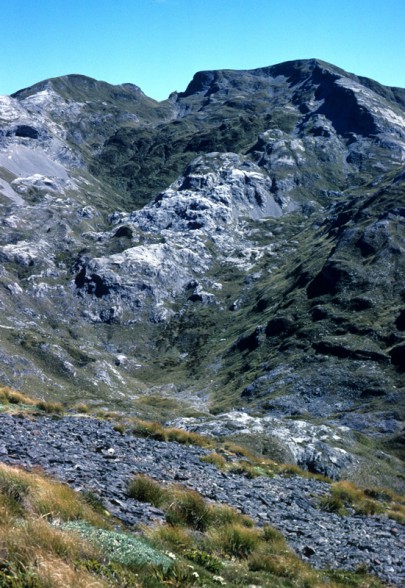Boulderfields of calcareous rocks
In this section
-
Inland & alpine
- Basic cliffs, scarps and tors
- Boulderfields of acidic rocks (non-volcanic)
- Boulderfields of calcareous rocks
- Braided riverbeds
- Calcareous cliffs, scarps and tors
- Calcareous screes
- Cliffs, scarps and tors of acidic rocks
- Cliffs, scarps and tors of quartzose rocks
- Cloud forests
- Frost hollows
- Granitic gravel fields
- Granitic sand plains
- Inland outwash gravels
- Inland saline (salt pans)
- Inland sand dunes
- Limestone erosion pavements
- Moraines
- Old tephra (>500 years) plains (= frost flats)
- Recent lava flows
- Sandstone erosion pavements
- Screes of acidic rocks
- Strongly leached terraces and plains
- Ultrabasic boulderfields
- Ultrabasic cliffs, scarps and tors
- Ultrabasic hills
- Ultrabasic screes
- Volcanic boulderfields
- Volcanic debris flows or lahars
- Volcanic dunes
- Young tephra plains and hillslopes

Foreground of tussockland bordering a bare calcareous boulderfield on Mt Arthur, western Nelson (Peter Williams)
Boulderfields occur where deposits of large (> 0.25m) fragments of fallen detritus accumulate on slopes. Calcareous rocks in New Zealand are primarily limestone and marble. As the calcium carbonate of the interstitial fines tends to dissolve (solution weathering), stabilized boulderfields have few or no fines between the boulders, making it difficult for plants to establish. For many years, lichens and mosses may be the only colonists. With time, calcareous boulderfields may be invaded from the margins by mat-forming plants or those spreading vegetatively. Pockets of fines can provide shaded mesic habitats that allow herbaceous plants to persist. Boulderfields provide fire breaks that allow remnants of vegetation to persist in fire-modified landscapes. There are many forms of limestone debris, and fine debris tend to support more species than boulderfields per se.
Synonyms
Boulderfields of limestone rocks, boulderfields of marble rocks.
Notable flora and fauna
Threatened plants found on boulderfields include the nationally critical Simplicia buchananii, the nationally endangered Canterbury limestone wheat grass (Australopyrum calcis subsp. optatum), Dichelachne lautumia, and the nationally vulnerable North-west Nelson marble clematis (Clematis marmoraria).
Threatened fauna include the nationally vulnerable black-eyed gecko (Mokopirirakau kahutarae).
Threat status
Vulnerable (Holdaway et al. 2012)
Threats
Montane calcareous boulder fields are invaded by herbaceous weeds such as thistles (Cirsium spp.) and high polyploid grasses, Chewings fescue (Festuca rubra), meadow grass (Poa pratensis) and cocksfoot (Dactylis glomerata) on the margins and small pockets of fines. At lower altitudes, calcareous boulder fields are very vulnerable to vines such as Old man’s beard (Clematis vitalba) and banana passion vine (Passiflora spp.). Browsing animals (goats, deer, chamois, hares, and possums) are likely to be present in some sites. Mining may pose a threat, but only at lower altitudes.
Where do they occur?
In North Island there are very limited calcareous boulderfields, associated with calcareous coastal cliffs in eastern Wairarapa at Castle point. In the South Island they are most abundant on the Arthur Range and Matiri Range, the escarpments of the Matiri Plateau, and to a lesser extent on Garibaldi Ridge, all in western Nelson. Also the Chalk Range in Southern Marlborough, in the Castle Hill basin of the Waimakariri River.
Further reading
Druce AP, Williams PA 1989. Vegetation and flora of the Ben More - Chalk Range area of southern Marlborough, South Island. New Zealand Journal of Botany 27: 167-199.
Park GN 1967. The vegetation and flora of Castlepoint and Cape Turnagain. Bulletin, Wellington Botanical Society 34: 6-18.
Rogers GM, Courtney SP, Heenan, PB 2018. The calcicolous vascular flora of New Zealand: life forms, taxonomy, biogeography and conservation status. Science for Conservation 331. Wellington, Department of Conservation.
Wardle P 1991. Vegetation of New Zealand. Cambridge University Press. Pp. 374-375.
Williams PA 1993. The subalpine and alpine vegetation on the Central Sedimentary Belt of Paleozoic rocks in north-west Nelson, New Zealand. New Zealand Journal of Botany 31: 65-90.

